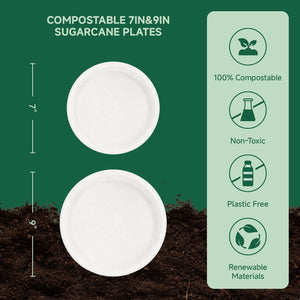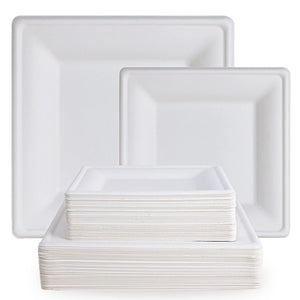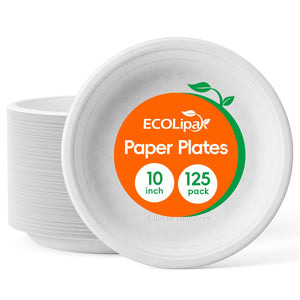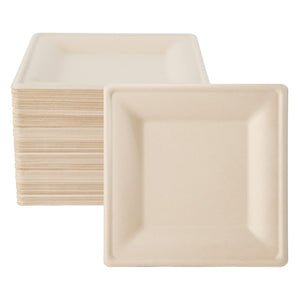You must dispose of bpi compostable plates in a specific way. The only certified method is a commercial or industrial composting facility. This process ensures they break down properly and return to the soil as nutrient-rich compost.
Remember This Rule 📝
Do Not place these plates in your recycling bin.
Do Not add them to a backyard compost pile.
Following a few simple steps helps you manage disposal correctly. You can complete the product's sustainable lifecycle and protect our environment.
STEP 1: CHECK FOR BPI CERTIFICATION
Before you do anything else, you need to confirm your plate is actually certified. Not all products labeled "eco-friendly" or "biodegradable" are truly compostable in a commercial facility. Only items with official certification are guaranteed to break down correctly.
LOCATING THE BPI LOGO
First, flip the plate over. BPI requires manufacturers to print the BPI Certification Mark directly on every certified product. You should see a distinct logo, often with a swirl design. This marking is essential. It allows compost facility workers to quickly identify items that belong in their compost stream. This rule ensures that only proper materials are processed.
UNDERSTANDING BPI CERTIFICATION
The BPI logo is more than just a symbol. It is proof that the product passed rigorous, science-based testing according to standards like ASTM D6400 and D6868. To earn certification, a product must prove it can:
Disintegrate: Break down into small pieces within 180 days in a commercial compost setting.
Biodegrade: Turn into healthy soil, water, and carbon dioxide, leaving no plastic fragments behind.
Be Non-Toxic: Produce a final compost that is safe for plants and contains no harmful chemicals or heavy metals.
Have No PFAS: Contain no intentionally added fluorinated chemicals, which are used for grease resistance but can harm the environment.
This third-party verification confirms the bpi compostable plates will safely return to the earth.
WHY CERTIFICATION IS KEY
Certification is your guarantee against "greenwashing," where companies make misleading environmental claims. Uncertified "look-alike" products can cause major problems. They often fail to break down, contaminating entire batches of valuable compost with plastic waste. This forces facilities to spend more money on sorting and can even make the final compost unusable for organic farms. When you choose a BPI-certified product, you help protect the integrity of the composting system and ensure your choice has a truly positive environmental impact.
STEP 2: PREPARE THE PLATE FOR COMPOSTING
Once you confirm the BPI logo, you need to prepare the plate for its next journey. Proper preparation is a quick but vital step that helps the composting facility process it correctly. This ensures your plate can become valuable, nutrient-rich soil.
SCRAPE OFF FOOD RESIDUE
Before you toss the plate into a compost bin, you should scrape any large pieces of leftover food into your trash or organics bin. While the plate itself is compostable, many food items are not suitable for large-scale composting facilities.
Items to remove include:
Large chunks of meat or bones
Excessive dairy products
Big globs of fat, oil, or grease
Produce stickers
Small amounts of crumbs, sauces, or light grease stains are usually fine. The goal is to remove bulk food waste.
THE IMPORTANCE OF SCRAPING
This simple action is very important for the composting facility. Large food scraps, especially meat and fats, can attract pests and create powerful odors. Removing them helps keep the facility clean and manageable for workers.
⚠️ Facility Focus
Scraping also prevents contamination. Certain foods can disrupt the delicate balance of microbes needed for decomposition. By sending a relatively clean plate, you help ensure the final compost is high-quality and safe for use in gardens and farms.
BREAK INTO SMALLER PIECES
This next step is optional but can be very helpful. If you have a moment, consider tearing or cutting the plate into smaller pieces. Tearing the plate increases its surface area. This allows the microbes at the commercial facility to break it down much faster. Think of it like a sugar cube dissolving faster than a sugar block. A little effort on your part helps speed up the entire natural process, making the system more efficient.
STEP 3: FIND A COMPOSTING FACILITY
Your plate is scraped and ready. Now you need to find a place that accepts it. The best place for bpi compostable plates is a commercial composting facility. Access to these facilities varies by location, so you will need to do a little research.
CHECK MUNICIPAL COLLECTION
Your first step should always be to check with your local government. Many cities and towns now offer curbside organics collection programs. You can find this information on your city's official waste management website. Look for contact details like a phone number or email for the solid waste manager.
Some cities have excellent programs that accept certified compostable products.
San Francisco has a mandatory program that has diverted over 2.5 million tons of compostable material since it began.
Minneapolis offers a city-wide organics collection service that also accepts BPI-certified items.
Start Local First 📍
Programs change and vary widely. Always confirm with your local waste hauler or municipality to see if they accept compostable serviceware in their green bins. This is the most reliable way to get accurate information for your specific area.
USE ONLINE SEARCH TOOLS
If your town does not offer curbside collection, online tools can help you find a facility. The U.S. Environmental Protection Agency (EPA) recommends using a free directory to locate options near you.
A great resource is FindAComposter.com. This searchable database, managed by BioCycle magazine, lists composting facilities across the United States and Canada. You can use it to find sites that accept food scraps and other organic materials. This tool helps you connect your waste to a facility that can process it correctly.
IDENTIFY DROP-OFF SITES
You might also find local drop-off sites in your community. These locations collect compostable materials from residents and take them to a commercial facility. These sites are often found in convenient public spaces.
Check for collection bins at places like:
Farmers' markets
Community gardens
Municipal recycling centers
For example, cities like Alexandria, VA, and Fairfax County offer food scrap drop-off stations at their local farmers' markets. These programs provide a great alternative when curbside service is not available.
STEP 4: CORRECTLY DISPOSE OF BPI COMPOSTABLE PLATES
You found a facility. Now you must get your plate there correctly. The right disposal method depends on the services available in your area. Following the rules ensures your plate completes its journey to becoming compost.
USE THE DESIGNATED GREEN BIN
If your city offers curbside organics collection, you will use a designated green bin. This is the most convenient option. However, you must follow local guidelines carefully. Programs have specific rules about what they accept.
Green Bin Rules 📝
Always check your local program's rules. Many accept BPI-certified items, but some have limitations.
They often accept paper cups and plates.
They may only allow BPI-certified compostable bags for lining your bin.
Other bioplastics, even if labeled "compostable," might not be allowed.
Placing unaccepted items in the bin can cause problems for the composting facility.
TAKE TO A DROP-OFF POINT
No curbside service? A community drop-off point is your next best choice. These sites collect materials and transport them for you. You need to check their rules before you go. Some locations only accept food scraps and do not take any serviceware, including bpi compostable plates. Others have specific hours.
For example, some farmers' markets have drop-off bins with set schedules.
Market Location |
Operating Hours (Seasonal) |
|---|---|
Madison Eastside |
Tuesdays, 4:00pm - 7:00pm |
Westside Community |
Saturdays, 7:00am - 12:30pm |
Always confirm the accepted materials list for your chosen drop-off site.
AVOID THE RECYCLING BIN
You must never place compostable plates in the recycling bin. This is the most common mistake people make. Recycling facilities are not designed to process these materials.
⚠️ Recycling Contamination Alert
Compostable items are made from plant-based materials like PLA. They need microbes, water, and oxygen to break down. Recycling plants are built to sort traditional plastics like PET and metals. When compostable products enter this system, they contaminate the entire batch. This forces facilities to send more material to the landfill.
Putting your plate in the right bin protects our recycling systems.
STEP 5: WHEN COMPOSTING ISN'T AN OPTION
Sometimes, you may not have access to a commercial composting facility. If you cannot find a curbside program or a local drop-off site, you need to know the next best steps. Understanding what not to do is just as important as knowing what to do.
THE TRASH AS A LAST RESORT
If you have no other choice, you must place the BPI compostable plate in the trash. This should always be your last resort. While it seems simple, this action has environmental consequences. Landfills are sealed, oxygen-poor environments designed for storage, not decomposition.
💨 Methane Matters
In a landfill, your compostable plate will break down under anaerobic (no oxygen) conditions. This process releases methane, a greenhouse gas over 25 times more potent than carbon dioxide. This contributes to climate change and negates the plate's sustainable design.
The plate will also take a very long time to decompose in a landfill, unlike the 180 days it takes in a proper facility.
HOME COMPOSTING LIMITATIONS
You should never put BPI-certified plates in your backyard compost pile or tumbler. Home compost systems do not create the right conditions for these products to break down. The main reason is temperature. BPI-certified items are made from bioplastics like PLA that require intense heat.
Industrial facilities consistently reach much higher temperatures than backyard piles.
Composting Type |
Typical Maximum Temperature |
|---|---|
Home Compost Pile |
50-65°C (122-149°F) |
Industrial Facility |
55-70°C (131-160°F) |
The material PLA needs temperatures above 55°C (131°F) to degrade effectively. Your home pile rarely stays this hot for long enough. As a result, the plate will not break down and will remain as a piece of waste in your finished compost.
PREVENTING RECYCLING CONTAMINATION
Finally, always remember to keep compostable plates out of the recycling bin. This is a critical rule. Recycling facilities are designed to process materials like glass, metal, and traditional plastics (PET, HDPE). Compostable products are considered contaminants in this system. When you add a compostable plate to your recycling, you risk contaminating an entire batch of valuable materials. This forces recycling centers to throw more items into the landfill, defeating the purpose of recycling. You protect our recycling infrastructure by putting the plate in the correct bin.
You now know the correct disposal method for bpi compostable plates is a commercial composting facility. This process turns your waste into valuable soil.
Final Reminders 📝
Do Not place them in the recycling bin.
Do Not add them to a home compost pile.
Cities like San Francisco prove that large-scale composting works. You can complete the product's sustainable journey. Take the final step and research the composting options available in your community today.
FAQ
What is the difference between biodegradable and compostable?
"Biodegradable" means an item breaks down over time. This process can take many years. "Compostable" means a product turns into healthy soil in a commercial facility. BPI certification guarantees this happens within 180 days, leaving no toxic residue behind.
Can I put these plates in my backyard compost?
You should not put BPI plates in a home compost pile. Your pile does not get hot enough to break them down. These plates need the high heat of a commercial facility, which consistently stays above 131°F (55°C), to decompose properly.
What if my plate has a shiny lining?
A BPI-certified plate's shiny lining is also compostable. It is made from a plant-based material like PLA, not regular plastic. You can send the entire plate to a commercial composting facility. The BPI logo confirms the whole product is safe to compost.
What happens if I put a BPI plate in the recycling bin? ♻️
You contaminate the recycling stream when you add a compostable plate. Recycling facilities cannot process these materials. Workers must remove the plate and send it to a landfill. This mistake makes the recycling process more expensive and less effective for everyone.









